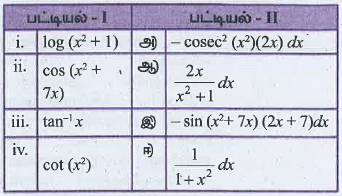(i) பெரும்பாலான மின்காப்பு பொருள்களில் முனைவாக்கம், புற மின்புலத்திற்கு நேர்த்தகவில் இருக்கும் (→Eext) (ii) ஒரு மின்காப்பு பொருள் மின் முனைவற்ற மூலக்கூறுகளால் ஆனவை. எது சரியான கூற்று.
I மட்டும்
II மட்டும்
இரண்டும் சரி
ஏதுமில்லை
The correct Answer is:A
Topper's Solved these Questions
Similar Questions
ஒரு சிலிக்கான் டையோடின் மின்னழுத்த அரண் [தோராயமாக].
View SolutionThe correct value of emf of cell is given by (i) E_("cell") = E_(OP) andode - E _(RP) cathode (ii) (i) E_("cell") = E_(RP) andode - E _(RP) cathode (iii) (i) E_("cell") = E_(OP) andode - E _(RP) cathode .
View SolutionIn honeybees, females are (i)____ having (ii)____ chromosomes and males are (iii)____ having (iv)____ chromosomes
View SolutionA variable, opposite external potential(Eext is applied to the cell :Zn∣∣Zn2+(1M)∣∣∣∣Cu2+(1M)∣∣Cu, of potential 1.1 V.respectively electrons flow from :
View SolutionAcylium cation has two resonating sturctures (I) and (II), R-underset(I)overset(o+)C=overset(* *)O:harrR-underset(II)C-=overset(o+)O: Which statement is correct of (I) and (II)?
View SolutionA sample space consists of 9 elementary outcomes E1,E2,…..,E9 whose probabilities are
P(E1)=P(E2)=0.08,P(E3)=P(E4)=P(E5)=0.1
P(E6)=P(E1)=0.2,P(E8)=P(E9)=0.07
Suppose A={E1,E5,E8},B={E2,E5,E8,E9}
(i) Calculate P(A), P(B) and P(A∩B).
(ii) Using the addition law of probability, calculate P(A∪B).
(iii) List the composition of the event A∪B and calculate P(A∪B) by adding the probabilities of the elementary outcomes.
Calculate P(−B) from P(B), also calculate P(−B) directly from the elementary outcomes of −B,
View SolutionWhat should be the starting point of straight line upward sloping supply curve, when
(i) ES=1
(ii) ES>1
(iii) ES<1
Draw the supply curves showing : (i) ES=1 (ii) ES>1 (iii) ES<1
View SolutionA varibale opposite external potential Eext is applied to the cell Zn∣∣Zn2+(1M)∣∣Cu2+(1M)∣Cu of potential 1.1 V when Eext<1.1V and Eext>1.1V respecitively electrons flow from
View SolutionIf the boundary of system moves by an infinitesimal amount, the work involved is given by dw=−PextdV
for irreversible process w=−PextΔV (where ΔV=Vf−Vi)
for reversible process Pext=Pint±dP≅Pint
so for reversible isothermal process w=−nRTln.VfVi
2mole of an ideal gas undergoes isothermal compression along three different plaths :
(i) reversible compression from Pi=2 bar and Vi=8L to Pf=20 bar
(ii) a single stage compression against a constant external pressure of 20 bar, and
(iii) a two stage compression consisting initially of compression against a constant external pressure of 10 bar until Pgas=Pext, followed by compression against a constant pressure of 20 bar until Pgas=Pext
Work done on the gas in single stage compression is :
View SolutionICOcl2←−−−AnilineC2H5MgI−−−−−→II. Products I and II are :
View SolutionI overset(O_(2))(larr)"Benzaldehyde" overset(NH_(3))(rarr) II, I, II are -
View SolutionChromosomes எது What is the cause of independent seclusion?
View Solutionकथन I : यदि P(E1=0.3 और P(¯¯¯E2))=0.6 तो P(E1,∪E2)=0.7
कथन II : P(¯¯¯E1)=I−P(E2)
View Solutionபின்வரும் வகையீடுகளைப் பொருத்துக
 . சரியான பொருத்தமானது
. சரியான பொருத்தமானது
View SolutionWrite the IUPAC name of the CH3−C∣CH3H−C∣OHH−CH3∣C∣CH3−CH3 compound.
View Solution
